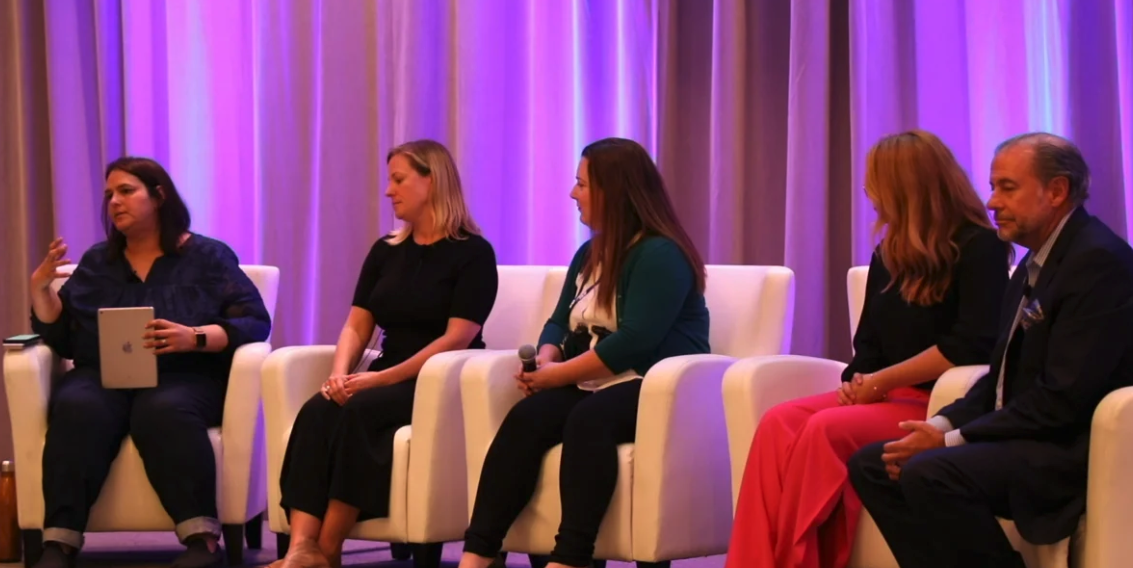Shawnna Sumaoang: Hi, and welcome to the Sales Enablement PRO podcast. I am Shawnna Sumaoang. Sales enablement is a constantly evolving space and we’re here to help professionals stay up to date on the latest trends and best practices so they can be more effective in their jobs.
Today, I’m excited to have Emily Elliott from Snowflake join us. Emily, I would love for you to introduce yourself and your role in your organization to our audience.
Emily Elliott: Hi, thanks for having me on today. My name is Emily Elliott, I’m the Director of Onboarding at Snowflake. if you don’t know what Snowflake is, it is a cloud data platform — just think secure and easy access to any data with near-infinite scalability.
SS: Fantastic. Emily, I’m excited that you’re here today. And as you mentioned, your main focus at Snowflake is really around new hire onboarding. In your opinion, what are the core elements needed to make an onboarding program successful?
EE: Yeah, I am all things onboarding, which actually was my role here at Snowflake and at my previous company, Cloudflare as well. I’ve kind of been living that onboarding life for many years actually. It’s a pretty fun area to be in because I feel like coming to a new company is a really potentially stressful life event for someone. I feel like I’m helping people during a difficult transition or kind of a stressful transition, but also helping my company be successful at the same time. I can’t really plug the onboarding role enough. It’s pretty fun, to be honest.
So, onboarding — I believe the core elements of it kind of change based on the hiring profile, but also the company’s kind of service or product that they’re offering. I have been responsible for onboarding at two highly technical companies that have extremely technical buyers and I think that this has lent me to focus a bit more on product and technical training rather than methodology training, if that makes sense. I think a lot of other core competencies that people focus on with onboarding is ‘let’s get the sales methodology in place’ and I think that that can work very well, especially if your sales reps are not as tenured.
I’ve had to focus a bit more on technical training, which I think is interesting and not a lot of other people would agree necessarily that should be a core element. But for me, understanding the product and the services that we offer is number one, right? Because I feel if they can’t come to boot camp and have a general conversation with me from a technical standpoint, we’re kind of in trouble — we’re in some hot water.
Luckily the company that I’m at now, all of the sales reps are highly tenured. I don’t need to teach them how to sell. I kind of just need to teach them how to sell Snowflake. But I would say product is a really number one core function and number two is, ‘do they really know what to do when they get back to their desk,’ you know?
It’s really important for me to focus on some practical application so that at the end of the day, they actually know how to do their daily job.
SS: I bet the technical side is actually something a lot of sales enablement practitioners in the B2B technology industry face within their organization.
Now, I want to talk about some of the challenges, because I think when sales enablement professionals are designing and implementing onboarding programs, they can run into some speed bumps, so I’d love for you to talk to us about what some of those are and what strategies you would recommend to overcome some of those obstacles.
EE: I think the biggest obstacle that I actually get with onboarding is that every single person at the company wants time in front of the new hires. They all believe that it should all be done in sales boot camp and then ends up being hours, or sometimes even days of just functional teams that tend to reside at headquarters that ended up burning so much of the new hires’ time.
For me, it’s really important for me to create templates for those presenters, or for any functional team, because at the end of the day, the reps start tuning out. They just really want to know three things: who’s going to help me, right? Like what does this team do? How do they support me? Best practices on how to work with that team? And then who’s the right person to go to for help?
I think limiting these meet and greet presentations and being really crisp and concise with why are we actually doing this training is highly important because every company spends a ton of money if they have an in-person sales boot camp, or in-person onboarding to send reps from all around the world to headquarters. So how are we really capitalizing on that face-to-face time? And I try and focus on how can we do something rather than let’s just listen to something. If this is something I could just listen to, we can record that and put that in an eLearning series. I think that’s a really big challenge. I’ve constantly faced that both at Cloudflare and at Snowflake, where everyone thinks that sales boot camp is the forum to tell sales everything in one week. It’s just not feasible. There’s no way that people can retain that much information anyways.
SS: Absolutely. Now you mentioned that this isn’t really a challenge that you have so much at Snowflake, but oftentimes I think new hire cohorts can often consist of many people with very diverse backgrounds and levels of experience. So, for other sales enablement practitioners that might be facing this challenge and since this is a role you’ve done at previous companies, how can sales enablement ensure onboarding really resonates with the new hires at all of all the varieties of levels that they might be coming in at?
EE: Yeah, huge. So, at Cloudflare, I actually onboarded SDRs, account executives, customer success, and solutions engineers, all in one class. Talk about varying levels of understanding of sales background, everything. We had highly technical solutions engineers with an SDR [where] it might be their first job out of college.
And that was a huge challenge for me at Cloudflare. What I did is I had about a day and a half of general sessions that were overarching to everyone, things that kind of could span the groups, if that made sense, and I ended up having to build individual learning tracks per function.
It was definitely hard from a scheduling perspective, but I would have multiple sessions running at the same time. I would have a prospecting session where the SDRs and the AEs could go to. At the same time, I was running SE boot camp or a specific customer success session, and I would have different breakout rooms. Then, we would kind of do certain things all together to keep the [cohesion] of the onboarding class — but I kind of had to separate people out to be honest, because I couldn’t really force a solutions engineer to sit through prospecting training, but these things had to be happening at the same time during onboarding.
For me, breaking out those learning paths per function was really, really important. I do think that that’s from a functional level kind of a way to organize things, but then an issue that I do have currently is that we have people that have come from in industry and have a very strong understanding of database basics, and then there’s a lot of people that we’re hiring from out of industry as well, that don’t have that technical background. So that’s kind of another twist on the same issue you could say.
What I’ve done for that is we’ve created a database basics pre-work and exam, and I can basically assign a series of like short videos and artifacts for people to watch if they choose, or they can just answer the questions. At the end of the day, if you can get through the exam, I kind of know that you’re at least on the same level of understanding. And so, if I can give this to them before they come to me live in boot camp, I know that we at least kind of have this base level understanding of the technical portion. That’s been really helpful to put in place in terms of base-level technical understanding.
SS: I love that. I think that’s a really great example. Now I want to elaborate on something else that you had also mentioned, which was that in addition to onboarding, you guys also offer on-demand e-learning so what advice would you have for reinforcing the knowledge that’s learned during onboarding and ensuring that it actually sticks long term? Because to your point, everything that is crammed down your sales reps’ throats in onboarding — there’s the retention challenge. So how do you go about trying to solve for that?
EE: I think this is super hard to solve for, to be honest. I’m really, really grateful that we just hired on my team a really successful seller. He is focusing on ongoing training and ensuring that reps are doing that, so we literally have a person dedicated to that function. But in addition to that, so reinforcing knowledge that they’ve learned in boot camp: I think the onboarding checklist is a really amazing tool, especially if you have the manager support and buy-in on the checklist, because if they know that they’re supposed to be working that with their rep, that will scale, right?
And if there are learning checks and things ongoing, that’s amazing. Actually, something that we’ve incorporated in this virtual sales boot camp that we’ve had to pivot to now are ongoing virtual check-ins for Q&A, which to be honest, we were not doing before this forced work-at-home situation and it’s actually really valuable. It’s something that I’m definitely going to continue doing in the future, something I’ve learned from this 100% remote kind of forced function here. It allowed the reps to go and try things that they learn in boot camp and fail or find success in, and then come back to us as an enablement team and have check-ins. That kind of virtual check-in with us and that Q&A time after they’ve had some time to go test the waters has actually been really, really huge because I’m also seeing what didn’t stick before and areas of my training that I think I might need to improve upon. It’s been really interesting.
I know a lot of other folks in sales enablement have a lot of ongoing e-learnings. I try not to bombard them with things. We have a self-guided learning journey where reps can kind of pick and choose those pieces as they go along. There’s also a 60-day onboarding plan within that and so a lot of times they come to boot camp and they haven’t completed those pieces. But I will say, I do think that ensuring that long-term stick is really difficult because I know myself and I don’t really tend to have concepts sink in completely until around the third time I’ve heard them, you know. I don’t think that most people just remember everything on the first time. Repetition is key.
SS: Absolutely. We’ve been doing a lot of studying into adult learning, and that’s definitely one of the key traits that we’ve heard — that you have to chunk it down to very small things, because we tend to remember only four things at once. And then make sure that you deliver it in repetition.
You started to talk about a topic that I think is also really important and really timely right now with a lot of organizations transitioning to remote work. One of those challenges for practitioners that have never had to is figuring out how to deliver onboarding virtually.
I would love for you to give our audience some best practices or key learnings from your pivot to virtual and also kind of talk maybe a little bit about some of the challenges. Things like the loss of that kind of in-person connectivity and how you guys are trying to kind of rebuild that sense virtually.
EE: Yeah, the way that we’ve kind of pivoted quickly here, I feel really lucky that the product marketing team at Snowflake is amazing. They literally recorded the most amazing trainings within less than a week’s time. I was pretty astonished actually. Within less than a week, I had this amazing training set to give to new hires before we did any live training. That was great. We beefed up that recorded content almost immediately. I was pretty astonished at how quickly they were able to turn it around for me.
Then what we did is we spread those boot camp trainings out over a longer period of time. And kind of like you were saying before, it’s those shorter bursts of training. People kind of had time to digest these little pieces, but not be overwhelmed by potentially sitting on a Zoom call for three days straight. So, we pivoted pretty quickly to ‘let’s beef up the recorded content and do a lot more of these shorter Q&A sessions’ to try and fill the gap.
I’m really lucky that the head of enablement at Snowflake, he actually decided for us to go virtual before things got pretty serious. I was in the office recording some of our leaders in person before anything actually got bad. We just decided to call March very early actually, and perform that virtually. I feel like I got really lucky where I had a little bit of a leg up on the situation, but having some face-to-face videos of the executives is huge. And I would say, as the head of enablement always says, ‘think YouTube, not Hollywood.’ Like it doesn’t have to be perfect. You know, it doesn’t have to be perfect. It just has to be some visual component where people can connect and even if we had some of the sales leaders recording themselves on their phone and sending that in, it’s better to have some sort of visual connection with your leaders rather than just listening to people speak over a PowerPoint, you know?
SS: Oh, absolutely. I think the more humanized you can make it, even if it’s virtual, the better. That’s fantastic. I think that’s really great advice for our audience. I’ve got a little bit of a tough one for the final question for you Emily, but I would love for you to talk to us about how you measure the success of onboarding.
EE: This is the million-dollar question and it’s the hardest one. In the past, the way that I was measured on the success of my onboarding was actually the portion of new sales hires that were hitting their ramp quotas. It was pretty targeted. It was a five-month ramp to full quota at my past company and I was kind of deemed mildly successful if a certain portion of those reps were hitting quota, but there were so many external factors to that, that it’s really difficult to be gold on something like that. There are things like hiring profile or which manager they had, and the amount of time I’m able to spend with them.
I was onboarding everyone globally. If I saw them for one week and then they went to Singapore and I never saw again, it’s hard to be gold on something like that. I think that any type of measurement in sales enablement is a really hot topic and also something that’s really difficult to quantify.
From a larger scope, there are a couple pillars that I hope to accomplish. When [a new hire] leaves my training, can they effectively deliver our message or pitch? Can they demonstrate a working knowledge of our products or services? And can they uncover prospect pain during initial conversations?
I would say the last piece of that is pipeline generation: do they really know what to do when they get back to their desk? It’s not really the most measurable entity for that larger scope discussion. And I find that often, anyone that’s focused on onboarding, you end up being measured on how many of those sales reps are hitting quota, right? And at the end of the day, that’s kind of what it ends up coming down to. As much as you don’t want to be the one responsible for that number, we are.
SS: It’s honest and it’s real and I think it’s what a lot of sales enablement practitioners are facing. They are obviously trying to tie themselves more closely to revenue and I think that that’s one of the quickest ways to associate onboarding to revenue targets. It makes a ton of sense.
Emily, thank you so much for joining me today, I really enjoyed our conversation.
EE: Thank you so much for having me.
SS: To our audience, thanks for listening. For more insights, tips, and expertise from sales enablement leaders, visit salesenablement.pro. If there’s something you’d like to share or a topic you’d like to learn more about, please let us know. We’d love to hear from you.




